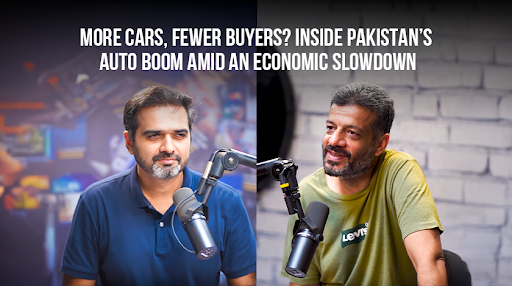If you think Pakistan’s auto industry is stuck in neutral, think again. Once dominated by a handful of players and year-long waiting lists, the market has shifted dramatically. Showrooms across Karachi, Lahore, and Islamabad are now filled with new crossovers, EVs, and hatchbacks bearing names few had heard five years ago.
Behind the glossy launch events and price cuts lies a deeper question: how did Pakistan’s car market transform from scarcity to surplus, and is the electric vehicle revolution truly next?
From Producer’s Market to Consumer’s Market
The transformation began with the Automobile Development Policy 2016‑21 (ADP 2016‑21), which opened the doors to nearly ten new manufacturers and introduced meaningful competition.
“Earlier, you had to wait 8-10 months and pay a premium to get a car. Now, companies are offering discounts, free registration, and even interest‑free monthly installments,” says Suneel Munj.
Where once three companies dominated, now consumers enjoy choice and competitive offers.
Localization: The Key to Survival
A recurring theme from Suneel is localization, producing parts within Pakistan rather than importing everything.
“No car company in the world makes 100% of its parts. They assemble components from specialized vendors. The same must happen here,” he explains.
The Greenfield element of the policy demanded localization within five years to keep costs manageable and competitive.
Suzuki continues to thrive precisely because of strong localization, which is why its Alto, Wagon R, and Swift remain dominant despite price hikes.
EVs: Are We Ready Yet?
Electric vehicles are the global buzz, but Pakistan’s readiness is still in question.
“EV adoption will start with two‑wheelers and three‑wheelers, not luxury cars,” says Suneel.
Most EVs available today cost over PKR 9–10 million, placing them out of reach for the average buyer.
The rapid evolution of EV technology also creates fears of fast depreciation.
The real revolution, he argues, will begin only when affordable electric bikes and small cars hit the market and are backed by proper battery standards and regulations.
The Rise (and Fall) of Sedans
Globally, sedans are yielding ground to SUVs and crossovers, and Pakistan is catching up.
“People now aspire to own crossovers. They’re the new status symbol, practical yet aspirational,” observes Suneel.
But the market structure is interesting: Pakistan’s market is still heavily hatchback‑oriented, not necessarily by choice but by affordability. There’s a gap between hatchbacks and crossovers, and a sweet spot around PKR 6–7 million where no strong player currently dominates. If Suzuki’s upcoming crossover model hits the right price, it could seize that entire mid‑tier market.
Pricing Mistakes Can Kill a Car
In Pakistan’s highly price‑sensitive market, getting pricing wrong can doom even a good car.
“Cars are sold based on perceived value, not production cost. Once a car is overpriced, no discount can fix its reputation,” says Suneel.
Recent examples show that even if manufacturers cut prices later, consumers lose trust.
“When a car’s price drops, buyers feel cheated. When prices go up, they complain publicly but secretly feel richer!” he laughs.
Plug‑In Hybrids: A Bridge Technology
For buyers puzzled over hybrid vs plug‑in hybrid, Suneel offers this guidance: know your driving habits. If your daily commute is under 40‑50 km, a plug‑in hybrid may allow you to drive on electric power alone, almost fuel‑free. But if you rarely drive, it may make no practical sense.
“It’s like asking for medicine without knowing your disease,” Suneel jokes.
He also cautions consumers to read the fine print; manufacturers often advertise fuel efficiency based on ideal lab conditions rather than real‑world driving.
Two‑Wheelers: Silent Electric Revolution Ahead
Pakistan’s two‑wheeler sector is poised for disruption as giants like Atlas Honda and Suzuki introduce electric bikes. However, Suneel warns against cheap, poor‑quality imports that could damage the EV segment’s reputation. With over 70 companies now licensed to sell EV bikes, he calls for strict battery and range standards for consumer safety and trust.
He also notes a social shift:
“It’s heartening to see more women riding bikes now in Karachi and Lahore. But safety must come first. Helmets are non‑negotiable.”
What the Industry Needs Most: Policy Clarity
If there’s one recurring problem in the sector, it’s inconsistent policy. Frequent flip‑flops on import rules and duties make it impossible for manufacturers to plan long‑term.
“We’ve waited nine years to see the fruits of the 2016 policy. Now that the industry is finally moving, please don’t pull the plug again.” Suneel emphasizes.
He argues for a consistent auto policy lasting at least 15 years, enabling manufacturers to localize confidently and giving consumers stability.
The Road Ahead
Despite economic turbulence, Pakistan’s auto sector has shifted gears —from scarcity to selection, from dependency to innovation. Events like the PakWheels Auto Expo showcase a market alive with competition, live test drives, and consumer-first experiences that were unthinkable a decade ago.
“It’s a transformative moment. Pakistani car buyers finally have choices, and that’s what a healthy market looks like,” says Suneel.
For manufacturers, it’s a call to innovate and price smartly. For buyers, it’s the first time they can truly drive their preferences. And for the industry as a whole, it’s proof that even amid uncertainty, growth finds a way. The road ahead may have bumps, but the engine of Pakistan’s auto market is revving — and there’s no stopping it.
Stay up to date with the latest automotive news, deals, reviews and much more, visit the PakWheel Blog.



تبصرے بند ہیں.